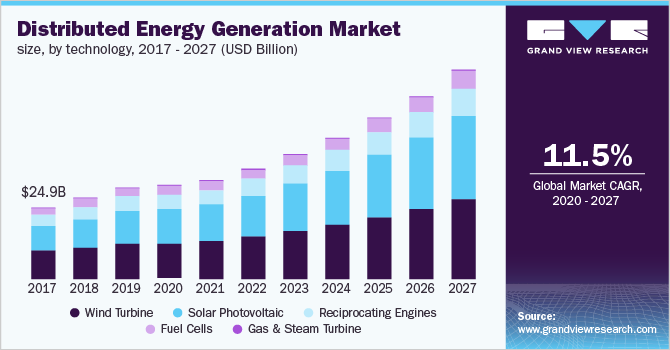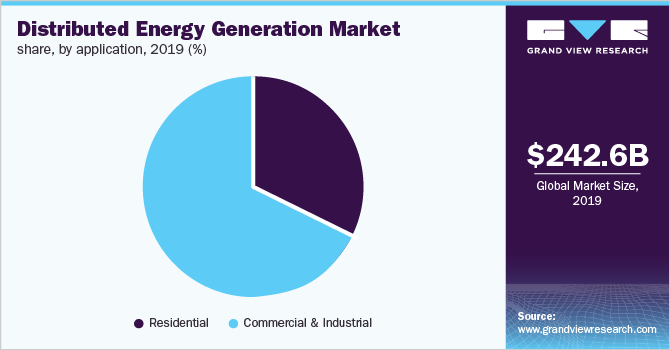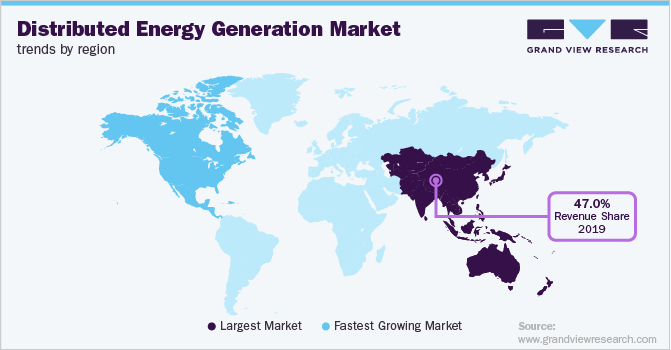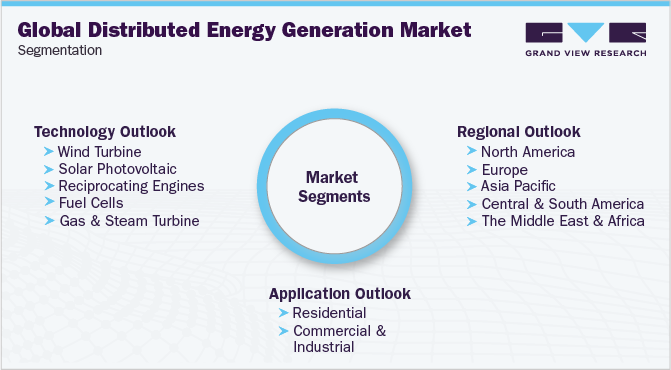- Home
- »
- Distribution & Utilities
- »
-
Distributed Energy Generation Market Size Report, 2020-2027GVR Report cover
![Distributed Energy Generation Market Size, Share & Trends Report]()
Distributed Energy Generation Market Size, Share & Trends Analysis Report By Application (Residential, Commercial & Industrial), By Technology (Fuel Cells, Solar PV), By Region, And Segment Forecasts, 2020 - 2027
- Report ID: 978-1-68038-027-9
- Number of Report Pages: 130
- Format: PDF, Horizon Databook
- Historical Range: 2016 - 2018
- Forecast Period: 2020 - 2027
- Industry: Energy & Power
Report Overview
The global distributed energy generation market size to be valued at USD 580.8 billion by 2027 and is expected to grow at a compound annual growth rate (CAGR) of 11.5% during the forecast period. Factors, such as growing environmental awareness, increasing government policies and Greenhouse Gas (GHG) emission reduction targets, and demand for energy, are expected to drive the market over the forecast period. Increasing R&D initiatives for the development of new technologies are also expected to augment the market growth. Schemes and incentives by the governments, such as feed-in-tariff in North America and the Asia Pacific, are likely to fuel the demand for DEG systems. Government schemes are aiming to promote the installation of such systems across industrial, residential, and commercial applications. These systems can be operated on-grid as well as off-grid depending on the application as well as their location.

Moreover, various benefits of DEG over conventional energy generation methods are expected to fuel the market growth. The U.S. market is anticipated to witness significant growth from 2020 to 2027. The deployment of DEG technologies has increased since 2014 owing to the adoption of supportive government policies, such as Production Tax Credit (PTC) that provides a per-kilowatt-hour tax credit for the electricity generated by DEG resource and Investment Tax Credit (ITC) that allows the tax credit to be taken based on the amount invested instead of the electricity produced.
Growing awareness about clean sources of energy is expected to enhance the demand for DEG systems. Moreover, DEG systems are cheaper than conventional power generation methods. Hence, the demand for a clean source of energy coupled with the economical costing of the product is estimated to have a positive influence on the market growth over the projection period.
Current development in regulatory policies across North America has resulted in the progress of the overall market. Factors including provincial renewable energy policy improvement in Canada, and successful implementation of energy auctions in Mexico, are resulting in a bigger deployment rate of DEG technologies in the region. Rising usage of solar PV rooftop arrangements for commercial and residential applications is assessed to be one of the vital trends that are boosting industry growth.
The COVID-19 pandemic has enormously stuck the Chinese economy with various other trade commotions. China, being one of the largest exporters of DEG goods, has observed an immense decline in the trading sector, due to lockdowns imposed in several parts of the countries. This is likely to affect the industry as the companies are pulling out of new investments and the government is cutting down the subsidies.
Distributed Energy Generation Market Trends
The basic characteristic of distribution energy of being a flexible technology i.e., the ability of the technology of onsite generation of electricity is the key element driving the market. This technology enables the generation of electricity in any location like at home, business, or industrial site. Distribution energy is environmentally friendly, cost-effective, and provides higher power quality. In addition, it is a more reliable energy solution than conventional energy sources such as oil, gas, and coal.
The availability of electricity in remote areas is still a major concern for many nations across the globe. The economic development of already developed or developing area outpaces the expansion of electricity supply in remote areas and with other regions facing the unavailability of energy due to the constraints on the ability to deliver power where and when it is needed. It has hence necessitated enabling local options for electricity transmission. This has thus provided great opportunities for the adoption of distributed energy generation systems.
Furthermore, energy loss from centralized power sources is projected to boost the market. The energy generated from centralized sources like hydropower, nuclear, coal, and natural gas tends to lose energy due to inefficiencies in the transmission process owing to the long-distance travel by the power. Whereas, energy generated through distributed systems provides high power quality.
However, the disinclination towards the adoption of distributed energy generation technologies is the primary cause hampering the market growth. This is attributable to the fact that these systems take up a lot of space and usually are located closer to the end-user the idea of which is not supported by many users. In addition, these systems are not much pleasure to the eye and also cause land-use concerns.Technology Insights
The fuel cells segment led the market in 2019 accounting for the largest share of over 36%. Fuel cells have numerous benefits over other conventional technologies. Fuel cells operate at higher efficiencies, convert chemical energy into fuel to electrical energy, and provide efficiencies up to 60% and have lower emission levels.
Solar PV technology, the fastest-growing form of renewable energy, is estimated to register the maximum CAGR from 2020 to 2027. In this technology, PV modules made from semiconductor materials are exposed to solar rays, thereby creating an electrical current. Wind turbine technology will register a significant growth owing to the growing number of installations of wind turbines in China, which is driven by the reduced feed-in tariffs.
Wind turbines find applications in agriculture, industrial, educational, and residential sectors. In agricultural fields, wind turbines provide energy to irrigation pivots, heating, and lighting applications and processing equipment. Challenging economic conditions and growing budget constraints are expected to restrain market growth. However, rising environmental concerns are expected to be the key factor responsible for segment growth.
Gasoline- and diesel-fueled reciprocating engines are commonly used for standby application and create a significant amount of pollution, in terms of noise and emissions. Hence, cleaner natural-gas fired engines are being developed to address the pollution concerns.
Application Insights
Commercial & industrial application types accounted for the largest market share of over 70% in 2019 owing to low product installation costs along with easy access to utility areas. In addition, governments around the globe are advancing policies to increase the deployment of renewable technologies in these applications as they provide higher efficiency, energy security, emission reduction, and higher resiliency compared to conventional electricity generation methods.
The growing adoption of solar photovoltaic units for power generation owing to its ability to provide quality and clean power is likely to drive the demand for DEG systems over the forecast period. Large-scale solar PV units are ideal for heavy industrial applications whereas small- to medium-scale units fulfill the energy demands in the commercial applications.

Frequent outages coupled with increasing electricity costs are expected to have a positive impact on the DEG industry growth. Favorable government policies coupled with supportive regulations, such as net metering, are expected to increase the number of DEG installations globally.
Heating and ventilation of floor spaces, along with the cooking and cooling applications have fueled the DEG systems demand globally. DEG systems, namely solar PV systems, are mounted on buildings that easily interconnect with the grid. These systems transmit the excess generation to the grid during the day and draw power from the grid during the night.
Regional Insights
Asia Pacific led the global market in 2019 accounting for the largest share of over 47%. The region will retain its dominant position expanding at the fastest CAGR from 2020 to 2027. The increasing demand for energy due to rising population coupled with rapid urbanization in countries, such as India, China, Indonesia, and Malaysia, is likely to be the key factor for the market growth. The product demand in China, in particular, is largely catered by the urban cities of the nation. The increasing disposable income levels in the country are also expected to drive the market in China.

North America is projected to have significant growth over the forecast period. The wind turbine has the highest market share in this regional market. However, solar PV is the fastest-growing segment due to declining costs, wider geographic distribution products under the solar lease, and third-party ownership models.
The product demand in Europe is largely catered by Germany and Italy. Demand for solar PV and wind turbines is expected to grow rapidly in the regional market owing to increasing renewable energy targets and the number of supportive policies set by the governments. The European Commission has set its target to reduce GHG emissions by 40% by 2030.
Fuel cells are another major technology used in Europe with CHP. It provides benefits compared to a single-fueled generator and its cost-effective installation boosts the demand for CHP systems in a variety of applications including residential buildings, oil & gas production facilities, and other commercial applications.
The MEA is expected to grow at a significant rate owing to the increased adoption of DEG for industrial applications. The solar PV system industry has been growing substantially, particularly in South Africa, owing to the growing need for clean energy, which, in turn, is expected to fuel the industry in MEA. The availability of solar and wind energy in MEA countries, particularly in Saudi Arabia and Egypt, is one of the primary factors attracting various end-use industries to opt for renewable energy sources.
Key Companies & Market Share Insights
The market is highly competitive owing to the increasing competition at the global level as the market is leading towards the lowering of the technological cost. The companies are investing in research and development to innovate new technologies.
Recent Developments
-
In June 2022, Cairn Oil & Gas announced to convert its Mangala pipeline to solar power. The company is targeting to install solar rooftop PVs in all 36 AGIs by 2025.
-
In June 2022, the infrastructure investment arm of Philippine billionaire Enrique Razon's announced its plans to construct the world’s largest solar power facility by joining hands with the growing number of local companies taking up the development of renewable energy.
-
In May 2022, Israel's Finance Ministry and the IIA (Israel Innovation Authority) announced a solar system initiative to test an artificial intelligence (AI) floating system intended to generate electricity by following the sun.
-
In October 2021, The NREL (National Renewable Energy Laboratory) announced the release of its Distributed Generation Market Demand (dGenTM) model, the 2021 version. The facility further stated that users can now access the latest version of the model on the dGen GitHub.
-
In April 2020, Oi SA Brazil's largest fixed-line carrier announced a renewable energy project intended to cut its operating costs by 400 million reais. The project is said to be 123 megawatts in a capacity involving 25 solar, hydroelectric mills, and biomass.
-
In February 2020, Indian state-owned EESL (Energy Efficient Services Ltd) announced to set up 1500 MW decentralized solar power plants by 2021.
Some of the prominent players in the distributed energy generation market include:
-
Vestas Wind Systems A/S
-
Capstone Turbine Corp.
-
Caterpillar
-
Ballard Power Systems Inc.
-
Doosan Heavy Industries & Construction
-
Rolls-Royce plc.
-
Suzlon Energy Ltd.
-
General Electric
-
Siemens
-
Schneider Electric
-
ENERCON GmbH
-
Sharp Corp.
-
First Solar
-
Mitsubishi Electric Corp.
-
Toyota Turbine and Systems Inc.
Distributed Energy Generation Market Report Scope
Report Attribute
Details
Market size value in 2020
USD 249.8 billion
Market volume in 2020
1,84,241.1 MW
Revenue forecast in 2027
USD 580.8 billion
Volume forecast in 2027
4,36,461.6 MW
Growth Rate
CAGR of 11.8% from 2020 to 2027 (Revenue-based)
Base year for estimation
2019
Historical data
2016 - 2018
Forecast period
2020 - 2027
Quantitative units
Volume in MW, revenue in USD billion and CAGR from 2020 to 2027
Report coverage
Volume and revenue forecast, company ranking, competitive landscape, growth factors, and trends
Segments covered
Technology, application, region
Regional scope
North America; Europe; Asia Pacific; Central and South America; Middle East & Africa
Country scope
The U.S.; Canada; Mexico; The U.K.; Germany; Italy; China; India; Australia; Brazil
Key companies profiled
Vestas Wind Systems A/S; Capstone Turbine Corp.; Caterpillar; Ballard Power Systems, Inc.; Doosan Heavy Industries & Construction; Rolls-Royce plc; Sharp Corp.; Suzlon Energy Ltd.; General Electric; Siemens; Schneider Electric; ENERCON GmbH; First Solar Mitsubishi Electric Corp.; Toyota Turbine; Systems Inc.
Customization scope
Free report customization (equivalent up to 8 analysts working days) with purchase. Addition or alteration to country, regional & segment scope.
Pricing and purchase options
Avail customized purchase options to meet your exact research needs. Explore purchase options
Global Distributed Energy Generation Market SegmentationThis report forecasts revenue growth at global, regional, and country levels and provides an analysis of the latest industry trends in each of the sub-segments from 2020 to 2027. For the purpose of this study, Grand View Research has segmented the global distributed energy generation market report on the basis of technology, application, and region.

-
Technology Outlook (Volume, MW; Revenue, USD Billion, 2016 - 2027)
-
Wind Turbine
-
Solar Photovoltaic
-
Reciprocating Engines
-
Fuel Cells
-
Gas & Steam Turbine
-
-
Application Outlook (Volume, MW; Revenue, USD Billion, 2016 - 2027)
-
Residential
-
Commercial & Industrial
-
-
Regional Outlook (Volume, MW; Revenue, USD Billion, 2016 - 2027)
-
North America
-
The U.S.
-
Canada
-
Mexico
-
-
Europe
-
Germany
-
The U.K.
-
Italy
-
-
Asia Pacific
-
China
-
India
-
Australia
-
-
Central and South America
-
Brazil
-
-
The Middle East & Africa
-
Frequently Asked Questions About This Report
b. The global distributed energy generation market size was estimated at USD 242.6 billion in 2019 and is expected to reach USD 249.8 billion in 2020.
b. The global distributed energy generation market is expected to witness a compound annual growth rate of 11.8% from 2020 to 2027 to reach USD 580.8 billion by 2027.
b. The high power segment accounted for a revenue share of 48.4% in the global distributed energy generation market in 2019. The increasing demand for energy due to the rising population of the region coupled with rapid urbanization in countries such as India, China, Indonesia, and Malaysia are likely to be the key catalyst for growth.
b. Some key players operating in the distributed energy generation market Vestas Wind Systems A/S, Capstone Turbine Corporation, Caterpillar, Ballard Power Systems Inc, Doosan Heavy Industries & Construction, Rolls-Royce plc, Sharp Corporation, Suzlon Energy Limited, General Electric, Siemens, Schneider Electric, ENERCON GmbH, First Solar Mitsubishi Electric Corporation Toyota Turbine and Systems Inc.
b. Key factors driving the distributed energy generation market growth include growing environmental awareness, increasing government policies and greenhouse gas emission reduction targets, and growing demand for energy across nations.
Share this report with your colleague or friend.
![gvr icn]()
NEED A CUSTOM REPORT?
We can customize every report - free of charge - including purchasing stand-alone sections or country-level reports, as well as offer affordable discounts for start-ups & universities. Contact us now
![Certified Icon]()
We are GDPR and CCPA compliant! Your transaction & personal information is safe and secure. For more details, please read our privacy policy.
We are committed towards customer satisfaction, and quality service.
"The quality of research they have done for us has been excellent."





